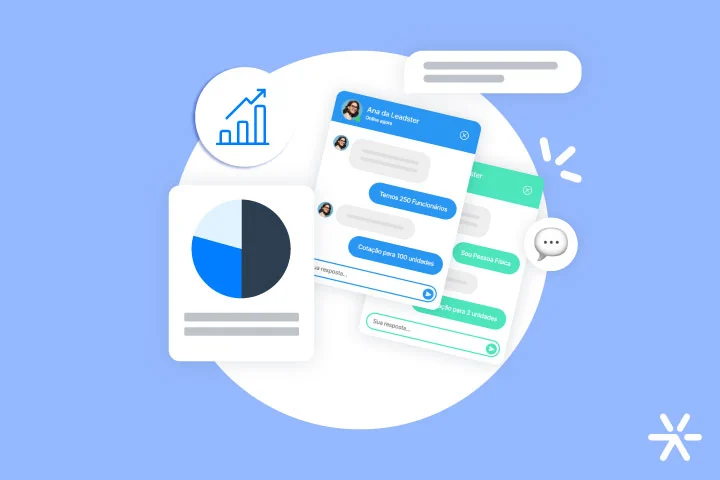Data-Driven Marketing: What It Is and How to Use Data to Generate More Leads for Your Company
“If you can’t measure it, you can’t manage it.” This is a well-known phrase in the corporate world, emphasizing how process control is linked to metrics.
And what does this have to do with Data-Driven Marketing? Everything!
In today’s article, we’ll cover this data-driven decision-making strategy, which has been and continues to be revolutionary for marketing.
What Is Data-Driven Marketing?

The term data-driven can be translated as driven by data.
In the marketing context, it represents a mindset, methodology, and strategic planning approach based on collecting and analyzing consumer information, with solid data at the center of decision-making.
And not just any data is tracked and analyzed.
This has been one of the biggest transformations in digital marketing.
Data-driven marketing relies on computational analysis and a large volume of analyzed digital data.
We’re talking about Analytics, Big Data, Business Intelligence, and Machine Learning.
These data sets help answer questions like who, when, how, and with what message a brand reaches its sales objectives.
The information turns into robust analyses, guiding actions, competitive advantages, and ultimately, business success.
🔎 Read also: 12 Digital Marketing Trends to Explore in 2023
What Are the Origins of Data-Driven Marketing?
Data-driven marketing emerged alongside the rise and expansion of the digital era.
As the internet became more accessible and people increasingly used mobile devices, businesses realized they had access to vast amounts of data about their customers and leads.
In the past, data was collected through traditional market research and analysis. However, with the growth of the internet, new sources of information emerged, such as website traffic, social media interactions, and online transactions.
From this, tools were developed to collect, store, and analyze these data—such as CRMs. This innovation enabled more precise decision-making in marketing strategies, personalizing messages and offers based on collected data.
As a result, data-driven marketing has become a fundamental pillar of digital marketing strategies, allowing companies to gain deeper insights into their customers and markets.
🔎 Read also: UTM: Learn What It Is, How It Works, and Its Parameters
What Does It Mean to Be Data-Driven, and How Can You Become More Data-Oriented?
To be data-driven in your company’s marketing strategies, it’s not enough to simply analyze data—you must also embrace the data-driven culture.
This culture is built upon several key pillars:
- Leadership
- Behavior
- Technology
- Processes
- Persistence
- Evolution
- Trust
- Courage
In other words, for a business to be truly data-driven, the entire company must be aligned, not just a few individuals. Leaders must guide employees through training and best practices.
Here are some essential tips to help you adopt this strategy:
- Set aside guesswork—Base your decisions on solid data, not intuition.
- Monitor consumer behavior changes—Trends shift constantly, so stay informed.
- Use the right tools—Leverage data collection, processing, and evaluation tools effectively.
🔎 Read also: Traffic Manager: Key Aspects to Succeed in This Profession
How to Implement a Data-Driven Culture from Scratch?

Introducing a new organizational culture isn’t easy, but the rewards are worth it. For data-driven marketing to become part of your business model, consider these essential steps:
- Manage data as strategic business assets
- Seek operational efficiency
- Ensure data governance
- Maintain data quality
- Develop KPIs for data management analysis
- Create innovative solutions based on research and development
- Integrate technology and data intelligence trends
- Define data policy standards
- Foster intellectual capital development
- Train and guide managers and teams
Invest in Team Education
Training your team is crucial for business success, regardless of the strategy you follow.
For smaller companies with fewer resources, data-driven marketing can seem complex—so the big question is: “Where do we start?”
The first step is team education, from leadership to all employees. Everyone must learn how to use the selected data tools.
Here are some courses to help your team get started:
📚 Udemy: Data Analysis & Culture, Excel for Data Analysis & Big Data, Business Intelligence Essentials
📚 FIAP: Big Data Ecosystem
📚 Domestika: Introduction to Data Visualization
📚 Lemonade School: Web Analytics & Data-Driven Marketing
Set Clear Objectives
Without clear objectives, no one knows what to track or where actions should lead.
The first step in becoming data-driven is defining what you want to achieve, how, and in what timeframe.
Define the Right Metrics
Once you establish objectives, determine the key metrics to track progress.
A good data point should be:
✅ Relevant to business goals
✅ Easy to understand
✅ Easily measurable
✅ Actionable—leading to informed decisions
Determine How Metrics Will Be Collected and Presented
Now, it’s time to select the right tools.
Define:
✔ Which platforms will track metrics
✔ How data will be organized for easy interpretation
✔ Who will analyze the data and how frequently
A crucial aspect here is to document the process so data analysis isn’t reliant on just one employee and past records are easily accessible.
Establish a Review Schedule for Metrics
Tracking consistently is essential. Define how often data should be reviewed.
For example, your marketing team might analyze data weekly, while executives receive a consolidated report monthly.
Define When Metrics Will Be Analyzed
To track performance intelligently, it’s also essential to define how often these metrics will be extracted.
If necessary, also determine how frequently the metrics will be presented to different audiences.
For example, the marketing team might review data weekly in team meetings, while the executive board may receive a consolidated report once a month.

Track Progress
The historical record of data and decision-making is fundamental to building a strong data-driven marketing culture.
Metrics and strategies may also evolve over time, especially if your company is just beginning to implement this approach.
Stick to the established timelines and processes to ensure consistency and effectiveness.
Analyze and Make Decisions
Now we arrive at the core of data-driven marketing—transforming data into accurate, strategic decisions.
Analyze the data at every stage of the customer journey (acquisition, conversion, retention, and advocacy).
Understand which investments delivered the best results, which content or efforts are worth revisiting, and which channels are the most effective.
And always remember—if the defined goal isn’t being met, adjust your strategies, actions, and approach. Changes can and should be made with a success-driven mindset.
Restart the Cycle
Data analysis is a continuous process, especially in data-driven marketing.
The steps outlined above work in cycles.
At the end of a campaign or a set timeframe, reevaluate your objectives, metrics, tools, processes, and strategies.
💡 Experience is the best teacher—apply what you learn and refine your approach!
What Are the Benefits of Data-Driven Marketing?

Using data-driven marketing comes with significant advantages.
Here are a few benefits that might interest you:
🔎 Read also: Why a Head of Growth Is Essential for Any Business
Ideal Consumer Segmentation
By using data-driven segmentation, marketing investments and ad campaigns become more efficient.
✔ Campaigns are highly targeted toward an audience that genuinely cares about the message.
✔ Communicating with the right consumer at the right time increases conversion rates.
✔ Marketing budgets are allocated more effectively.
Creating Relevant Content
The era of generic marketing content is over.
Consumers today are interested in content designed for their individual needs, providing relevant information, products, and services tailored to them.
With the analysis and application of Data-Driven Marketing, content is also based on information and the materials that yield the best results, rather than relying solely on empirical insights and potentially distorted perceptions of consumers.
Possibility of Conducting A/B Tests
A/B testing is a way to present real audiences with materials or campaigns in two versions, but with small modifications in the article or visuals.
Both versions are shown to the audience during a test period, and the one that performs better is used as the fixed version for the remainder of the campaign.
This type of strategy is only possible through data analysis aimed at decision-making.
By investing in the version with the best performance, you improve click and conversion rates.
Total Integration with Sales
The integration between marketing and sales teams is essential for achieving good results.
Many companies struggle with this aspect, and Data-Driven Marketing can be a solution for sharing important and relevant data between the two areas.
What Are the Main Tools of Data-Driven Marketing?
To track, extract, and create analysis reports for your company’s and marketing sector’s data, there are many tools available on the market.
Often, the choice of tools depends on objectives, types of materials and campaigns developed, communication channels used, and the metrics being monitored.
You can also combine multiple tools for even more analytical and specific results for each of the factors mentioned above.
Keep in mind that the chosen tools should ensure aspects such as processing speed, Big Data storage, easily identifiable indicators, and a simple interface for displaying results.
Some of the most widely used tools in Data-Driven Marketing include Google Analytics, Google Search Console, Google Ads, Google Data Studio, Facebook Ads, automation tools, email marketing platforms, lead tracking systems, CRMs, e-commerce platforms, and Business Intelligence tools.
Want to dive deeper into any of them?!
Google Analytics 4
Google Analytics 4 is the new version of Analytics, replacing the Universal version.
This tool is essential for tracking and analyzing key data on your website.
With it, you can create custom reports, segment data by conversion location and source, analyze by periods, and more.
One of the major revolutions in this new version—GA4—is the shift to event-based data collection instead of session-based tracking. This significantly changes the understanding of how your website is being used.
Other key changes include:
- A new data collection model for websites and apps, providing more insights into the customer journey.
- The data capture model now uses events instead of sessions.
- Enhanced privacy control: third-party cookie-free tracking, behavioral modeling, and conversion estimates.
- Predictive behavior features.
- Direct integrations with media platforms.
🤿 Dive deeper: Google Analytics 4: How to Access, Configure, and Use
Google Data Studio
Google Data Studio is the ideal tool for creating reports and dashboards to evaluate and measure your results.
It offers high customization levels in your analysis and transforms raw data into relevant insights for your company.
DataBox
Developed by Microsoft, DataBox is a data visualization tool.
This platform is designed for users without programming or data analysis knowledge, allowing them to add, modify, and visualize data from various sources in a single interactive dashboard.
RavenTools
Although RavenTools is a cloud-based SEO platform, it also provides reporting functionalities for tracking metrics.
Its strength lies in offering ad management, keyword research, and performance reporting all in one place.
Metabase
Metabase is an open-source data analysis tool that allows users to visualize and query data through an intuitive interface.
It supports multiple databases and enables users to create shareable custom dashboards.
This tool is an option for companies looking to implement an internal data analysis solution without investing heavily in time and money.
CRMs
Customer Relationship Management (CRM) systems help manage customer relationships by organizing information, visualizing data, and developing sales contacts.
Typically, these platforms use a pipeline format where leads can move through different stages of the customer journey or sales funnel.
Popular CRMs include:
- Fleeg
- Simply CRM
- Snov.io
Marketing Automation
Marketing automation tools centralize data and automate marketing and sales processes.
These tools include automation flows, lead attribution, email marketing, database segmentation, lead generation and tracking, A/B testing, and reporting.
Some of the best marketing automation tools are:
- RD Station Marketing
- LAHAR
- ActiveCampaign
🤿 Dive deeper: 19 Best Marketing Automation Tools in 2023 – With Reviews!
Leadster
Leadster is a conversational marketing platform that helps capture and qualify leads through a chatbot for marketing and sales.
It includes smart call features, lead qualification with lead scoring, A/B testing, over 200 integrations, and meeting scheduling.
Leadster also offers a performance dashboard, allowing users to view conversion data, a complete list of generated leads, and optimization tips.
Additionally, you can filter data by date, access devices, and active flows.
Are you ready to implement a data-driven marketing strategy in your company?
If you want to learn more about Performance Dashboards, how this feature can make your life easier, its benefits, and how to better manage your data, check out our content: Leadster Features: Real-Time Results with the Performance Dashboard!
Give it a try without fear—I guarantee it will make your routine even more productive! 😉








